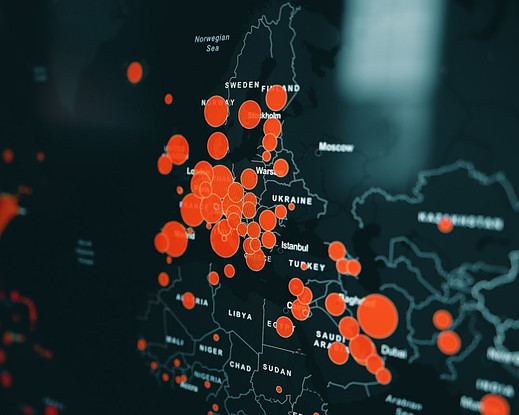Hundreds of diseases outbreak each year. The swine flu was the most recent pandemic outbreak in the world in 2009 and now the COVID-19.
The swine flu hit the US between April 2009 and April 2010. The new strain H1N1 originated in Mexico in the spring of 2009. It was a pandemic that infected 1.4 billion people across the globe. “The swine flu is a respiratory disease caused by typed A influenza virus in pigs which are common in pig herds,” stated cnn.com. The swine flu occurs in people when those people are in contact with infected pigs. It is called a “variant influenza virus.”
The COVID-19 or also known as the Coronavirus, 2019 coVid-2, or SARS-CoV-2 emerged from the city of Wuhan, China in the Fall of 2019 and spread over 192 countries and territories. The virus could jump from animal to human such as bats. Based in the Journal of Nature Medicine article published on March 17, 2020, the COVID-19 is the product of natural evolution. While other reports suggested the virus was man-made, we are still learning and understanding the virus more over time. This article is not trying to convince you one way or the other. It is primarily to inform you of the differences and similarities between Coronavirus vs Swine Flu, how the viruses impact the economy and you?
How are they different?
H1N1 flu was less contagious than the novel Coronavirus. According to a review published in the journal BMC Infectious Disease, the measurement of contagious is through a basic reproduction number called the R-nought value. It is the expected number of individuals who can catch the virus from one infected person. The R-nought number for the H1N1 virus was 1.46 and the R-nought number for Coronavirus is between 2 and 2.5 at the moment.
According to the CDC, the 2009 flu affected 80% fatalities mostly the population younger than 65 years old. Older people seemed to have built up enough immunity to H1N1 so they were not impacted as much. The Coronavirus is quite the opposite. It is the most deadly for people over age 60 with underlying health issues. However, one may not take it lightly even if a person is under 60. That person may not have severe symptoms but can pass the virus to someone else who is vulnerable.
Also, stated by Livescience.com, the flu virus spread in respiratory droplets and airborne particles while 2019 coVid-2 spread primarily through respiratory droplets and maybe in feces.
COVID-19 affects some people differently. There would be mild symptoms or may not experience any symptoms at all, according to the CDC. Unlike the swine flu, COVID-19 has a longer of incubation period of between four and fourteen days, which means an infected person can carry and spread the virus for up to two weeks before experiencing any symptoms.
The US responded to both virus differently. According to Livescience.com, “A major difference in response is that we were better prepared for a pandemic (at least in the U.S.) years ago,” Strathdee said.
What went wrong? There were two major issues stated by Livescience.com:
- Major test delayed – Most labs received faulty test kits. It took time to develop and send out replacement kits. Most labs ran out of testing supplies while COVID-19 continued to spread undetected. Finally, the FDA announced on February 29 labs can begin testing with their own lab-developed tests without prior approval with certain conditions. Please visit Livescience.com for further details.
- Social Media – Social media didn’t exist in 2009. Because we are in an era of electronic age with a wealth of information at our fingertips through social medial, missed information about the disease was spread faster than the virus. This caused even more panic and fear.
How are they the same?
They both cause fever, cough, body aches, fatigue, sometimes vomiting and diarrhea. They can be mild or severe and even fatal in some cases. It can cause a respiratory issue that leads to serious problems such as pneumonia.
Both can transmit from person to person through droplets in the air from an infected person coughing, sneezing, or talking. Both can spread by an infected person for several days before their symptoms appear.
Neither virus is treatable with antibiotics, which work only on bacterial infections. Both may be treated by addressing symptoms, such as reducing fever. Severe cases may require hospitalization and support such as mechanical ventilation.
Because the virus can spread through saliva or mucus so for prevention, thorough hand washing at least 20 seconds, coughing into the crook of your elbow, staying home when sick and limiting contact with people who are infected, and boost your immune system with vitamin C, Andrographis, and/or food that are rich in vitamin C such as oranges, grapefruits, kiwis, etc.
Statistics
Swine Flu – H1N1
- Cases – The Centers for Disease Protection and Control (CDC) estimated about 1.4 billion cases across the globe and about 60.8 million cases were from the US.
- Hospitalizations – about 274,304 were from the US
- Deaths – Between 151,700 to 575,400 people worldwide, 80% occurred in people younger than 65 years old. Approximately 12,469 deaths were from the US.
- The mortality rate: 0.02% from 2009 to 2010 according to businessinsider.com
Coronavirus – COVID-19
As of March 23, 2020 and ongoing, the following statistics are from worldometers.info updated China’s NHC:
- Cases: 368,936 worldwide and 41,526 cases were from the US.
- Deaths: 16,307 worldwide and 501 deaths were from the US.
- Recovered: 101,069 worldwide and 187 recovered from the US.
- Mortality rate: 3.4% is the current average mortality rate estimated by the WHO as of March 3, 2020.
How are the virus affecting the economy?
The swine flu pandemic seems mild in comparison to the Coronavirus. As the Coronavirus spread rapidly into March 2020 creating lots of  uncertainty, the stock market crashed by the end of February 2020. U.S. Stocks lost nearly 12%. It was the worst week for stocks since the financial crisis in October 2008, according to Time.com. Even gas dipped below $2/gallon in certain areas of Orlando in the week of March 23, 2020.
uncertainty, the stock market crashed by the end of February 2020. U.S. Stocks lost nearly 12%. It was the worst week for stocks since the financial crisis in October 2008, according to Time.com. Even gas dipped below $2/gallon in certain areas of Orlando in the week of March 23, 2020.
Airlines, hotels, and travel industries struggle to stay afloat because of travel restrictions and people are traveling less. As Coronavirus cases increase, certain states with the highest and quickest growing number of cases in the US are declaring a state of emergency. Each state has its own executive order to prevent the spreading of the virus. Everyone is encouraged to stay at home and travel only for a necessity such as work, grocery store, or emergency situation. You can walk your dog(s) but stay at a distance of six feet when interacting with others.
All meetings, seminars, conventions, etc with more than 10 people involved are canceled. Disney World, Universal Studios, and other theme parks are closed until April 1, 2020. Restaurants are open only for take-outs. Gyms and fitness centers are ordered to be closed. Grocery stores are open but certain supplies such as toilet paper and sanitizers are limited. Students are home from school for at least 2 weeks. Schools are resuming for my kids on March 30 as distance learning which is the same as online classes.
Conclusion
Where do we go from here? How long will this take? The Swine flu lasted from Spring 2009 until Spring of 2010. That was a full year. However, we did not have similar restrictions that we have now with the Coronavirus. With the encouragement of social distancing, we are leaning more and more toward working from home, shopping from home, and learning from home.
Finding time on your hands and itching to make a little money or a lot of money? There are many opportunities or make your own. Here are a handful of articles for online opportunities:
- Affiliate Marketer – It is not an overnight get rich scheme. The potential to generate lots of money is great. (Totally RECOMMENDED)
- Over the Phone Language Interpreter – If you are fluent at least two languages, phone language interpreters are on demand.
- Online Jobs for Writers – If you love to write, this would be a great job for you.
- Fill out Surveys – This is time-consuming but maybe worth it for some people to make $10 here or $20 there. It’s still money.
- Five Great Ideas for Online Business – No Certification needed
Coronavirus may take months or even longer to calm down. China, where it all started, seemed to have the virus under control at the moment. Their outbreak started December 2019 with a sign of slowing down in March 2020. Meanwhile, boost up your immune system with vitamin c, eat well with a good diet and exercise. Stay calm and enjoy your time with family.
I love to hear your thoughts and experience with the Coronavirus, the Swine Flu, or any flu. Did you ever have the flu and how did you get well? How did it impact you? Please leave your feedback or questions below.
We are still discovering and learning more about the COVID-19 every day and the status is constantly changing. Here are some great resources with up to date information for COVID-19:
WHO – World Health Organization: https://www.who.int/emergencies/diseases/novel-coronavirus-2019
The Joint Commission resources: https://www.jointcommission.org/covid-19









2 thoughts on “Coronavirus Vs Swine Flu – How Does It Impact You?”
Hi Ha,
Thanks for this informative article about CoronaVirus, and people should be much more careful about personal hygiene during this particular time. In my country, we are taught by the government to measure body temperature and wash our hands regularly to keep ourselves and others safer. The most important part is to wear a mask to prevent the virus from the air transmission, and I believe it works well to avoid both CoronaVirus & the flu.
I use a mask for air pollution every single day before Coronavirus, so for me, it’s just the same as my daily routine. But for people who don’t have a habit of wearing masks, it should be a hassle. Not sure whether people have the practice to wear masks in your region? At least for this period, people should take this as the top priority to remain healthy.
Thanks for sharing,
Matt
Thank you, Matt, for visiting my post. I appreciate your feedback. Yes, now more people are wearing face masks where I am also. They did not wear them in the past. We have a shortage of masks because the demand is so great. The masks are certainly great for protection against air pollution. Here is a great article was written by WHO (World Health Organization) regarding masks and the Coronavirus –> When to Use a Mask?.
Yes, stay healthy by eating a balanced meal and exercise are keys to boost your immune system. Washing your hands and do not touch your face with your hands is also important as well. It is a lifestyle change. Thank you again for your thoughts.
Be Well!
Ha —